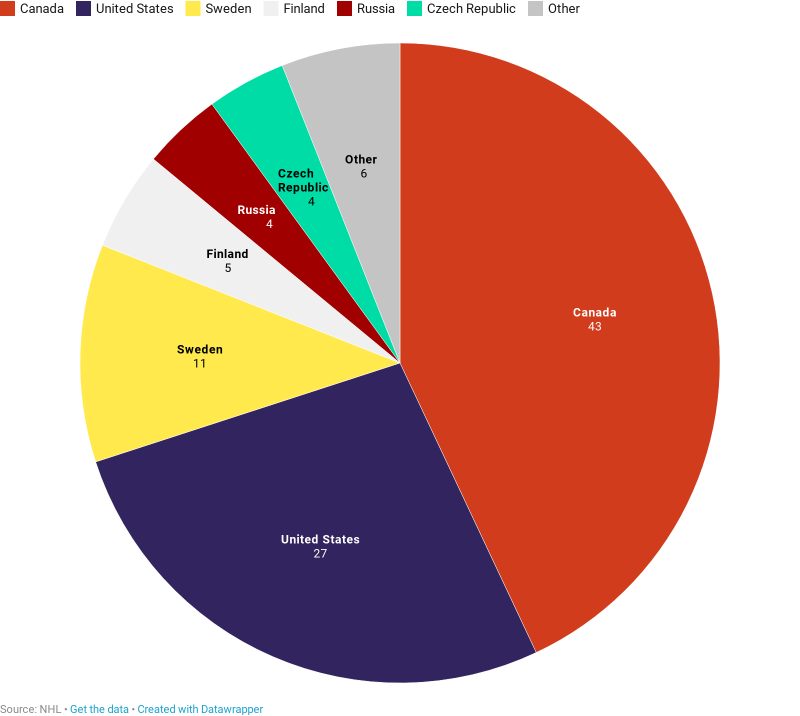Interactive dashboard by Nick Kirmse
View full screen desktop version of interactive dashboard
On a phone? View the mobile version
We all know that Canadians dominate the NHL, but do you know what team has the most Canadian players? Or what province has produced the most current NHLers? Or perhaps you live in an NHL-less city or hundreds of kilometres away from the nearest big league arena and are looking for the perfect team to cheer for or a jersey that pays tribute to a hometown hockey hero? Look no further: in this story, CTVNews.ca has analyzed NHL roster data to answer these questions and more.
In this visual feature, you will be able to:
1. Browse through an interactive map that shows the birthplaces of every current Canadian NHL player. When multiple players hail from the same place, use the arrows in the pop-up screen to browse through their profiles. Searches can also be toggled by province and/or team.
2. See what countries have produced the most current NHL players.
3. See how the provinces compare when it comes to how many current NHLers they have bred, both per capita and by player totals.
4. See what the six most Canadian teams in the league are, player-wise. Only two of them are actually in Canada!
Based on this data, here are some interesting facts…
Canada at a glance
Nearly 43.1 per cent of all 771 current NHL players hail from Canada, followed by the United States at 26.7 per cent, Sweden at 10.5 per cent, Finland at 5.3 per cent, Russia at 4.4 per cent and the Czech Republic at 3.8 per cent. A total of 21 countries have players in the league.

With 140 players, Ontario has produced the most current NHLers, followed by Quebec (46), B.C. (45) and Alberta (43).
On a per capita basis, Saskatchewan takes the Canadian hockey crown with 2.15 per 100,000 people playing in the NHL, followed by Manitoba (1.79) and P.E.I. (1.32).
Toronto might not have brought home a Stanley Cup since 1967, but with 28 current players playing for 20 different teams, at least Canada’s most populous city is dominating the NHL in other ways. Other cities notable for producing lots of current NHLers include Edmonton (17), Winnipeg (13), Calgary (12), London, Ont. (11) and Montreal (10).
There are no current NHL players from Newfoundland and Labrador and the three territories.
Some team takeaways

Florida Panthers goaltender Roberto Luongo, from Montreal, stops an attempt by St. Louis Blues' Robert Thomas, from Aurora Ont., on Dec. 11, 2018. (AP Photo/Jeff Roberson)
With 17 Canucks from six provinces, the St. Louis Blues are currently the most Canadian team in the NHL, followed by the Montreal Canadiens (17 Canadians from five provinces), the Florida Panthers (16 from five provinces), the Vegas Golden Knights (15 from six provinces), the Edmonton Oilers (15 from 4 provinces) and the New York Islanders (14 from seven provinces).
If you’re from NHL-less Saskatchewan and looking for a team to root for, consider the St. Louis Blues, which boasts four local boys.
When it comes to local legends, the Ottawa Senators have the most players born in-province (eight), followed by the Toronto Maple Leafs (seven), Montreal Canadiens (five), Edmonton Oilers (four) and Vancouver Canucks (two).
With only five Canadians on their rosters, the Minnesota Wild and New Jersey Devils are the least Canadian teams in the NHL.
Every NHL team has Canadians and Americans in their lineups. Only three teams – Florida, Montreal and Winnipeg – lack a Swede.
With players from eight different countries, the Chicago Blackhawks, Columbus Blue Jackets and Washington Capitals share the title for being the NHL’s most international teams.
With only four countries represented, the St. Louis Blues is the league’s least international team.
Notes on the data
All 2018-2019 season roster data has been taken from the NHL’s media site and is current as of Nov. 27, 2018.
The data includes all Canadians currently signed to NHL team contracts, though some of these players may be on injury reserve lists or playing for AHL affiliates.
The locations on the map denote birthplaces. Where a player actually grew up could be different. Towns and cities that are no longer independent political entities -- such as Scarborough, Ont. and Cole Harbour, N.S. -- have been folded into their current amalgamated municipalities, where possible.
All provincial population figures comes from 2017 Statistics Canada data.
If you notice any problems or have something to add, please click on the 'Report Error' button below.

